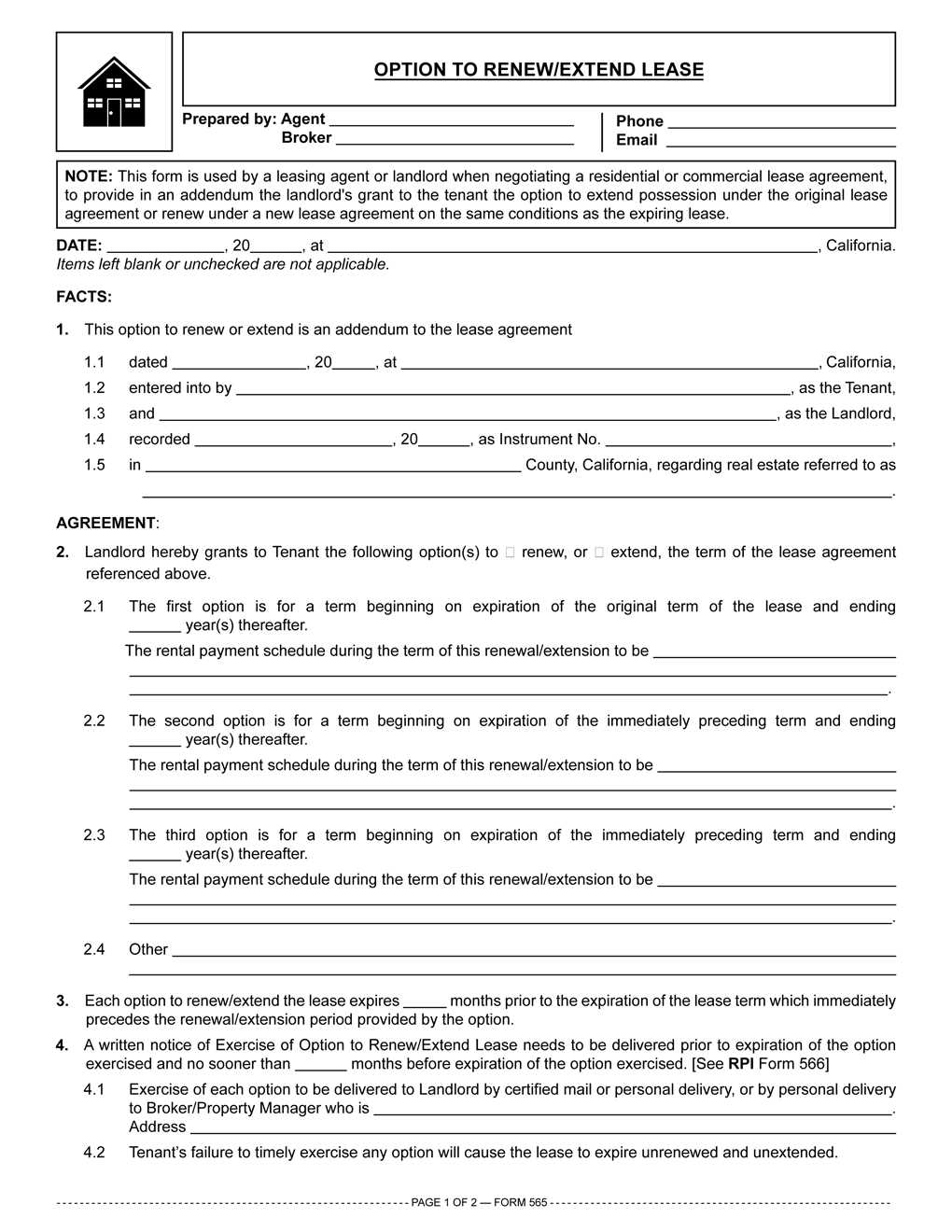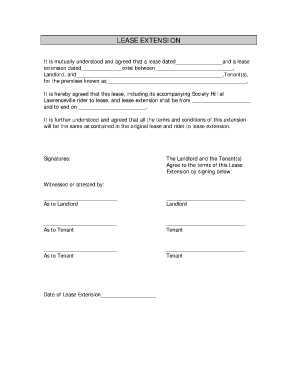What is Lease Extension?
Definition
A lease extension is a legal agreement that extends the lease term between a landlord and a tenant. It is a mutually beneficial arrangement that provides the tenant with the opportunity to continue living or operating a business in the leased property, while allowing the landlord to maintain a steady rental income.
Importance and Benefits

Lease extensions are important for both landlords and tenants. For tenants, it provides stability and the ability to continue their current living or business arrangements without the need to search for a new property. It also allows them to avoid the costs and inconveniences associated with moving. For landlords, lease extensions ensure a consistent rental income and reduce the risk of having a vacant property. It also saves them the time and effort of finding new tenants.
Furthermore, lease extensions can be beneficial for both parties in terms of negotiation. It provides an opportunity to review and update the terms of the lease, such as rent amounts, maintenance responsibilities, and any other provisions that may need to be modified.
Lease Extension Process
The lease extension process typically involves the following steps:
- Initiating the request: The tenant initiates the request for a lease extension by contacting the landlord and expressing their interest in extending the lease.
- Negotiation: The landlord and tenant negotiate the terms of the lease extension, including the duration of the extension, any changes to the lease agreement, and any potential rent adjustments.
- Registration: In some jurisdictions, lease extensions may need to be registered with the relevant authorities to ensure their legal validity.
It is important for both parties to carefully review the terms of the lease extension before signing the agreement to ensure that all their rights and obligations are clearly defined and understood.
Overall, lease extensions provide a convenient and mutually beneficial solution for both landlords and tenants, allowing for continued occupancy and a stable rental income.
Definition, Importance, and Benefits
A lease extension refers to the process of extending the duration of a lease agreement between a landlord and a tenant. It allows the tenant to continue occupying the property beyond the original lease term. Lease extensions are common in rental agreements, especially in situations where tenants wish to stay in the property for a longer period.
The importance of lease extensions lies in the flexibility it offers to both landlords and tenants. For tenants, it provides the opportunity to secure a longer-term lease, ensuring stability and continuity in their living or business arrangements. It eliminates the need to search for a new property and go through the hassle of moving. For landlords, lease extensions can help maintain a steady rental income and avoid the costs associated with finding new tenants.
Furthermore, lease extensions can be seen as a win-win situation for both parties. Tenants can avoid the inconvenience and costs of moving, while landlords can maintain a stable rental income. It also fosters a positive landlord-tenant relationship, as both parties are working together to find a mutually beneficial solution.
Lease Extension Process
1. Assessing the Lease Terms
2. Determining Eligibility
3. Seeking Legal Advice
It is highly recommended to seek legal advice from a qualified professional who specializes in lease extensions. They can provide guidance on the process, help negotiate favorable terms, and ensure all legal requirements are met.
4. Serving a Section 42 Notice
Once eligibility has been established and legal advice has been sought, the next step is to serve a Section 42 Notice to the landlord. This notice formally requests a lease extension and sets out the proposed terms, including the length of the extension and any changes to the rent.
5. Negotiating the Terms

6. Finalizing the Lease Extension
Once the terms have been agreed upon, a formal lease extension agreement will need to be drafted and signed by both parties. This agreement should outline all the agreed-upon terms, including the length of the extension, the rent amount, and any other relevant provisions.
7. Registering the Lease Extension
Finally, it is important to register the lease extension with the appropriate government authority or land registry. This ensures that the lease extension is legally binding and provides protection for both the tenant and the landlord.
By following these steps and meeting all legal requirements, tenants can successfully extend their lease and continue to enjoy their rented property for an extended period of time.
Lease Extension Process
When considering a lease extension, it is important to understand the process involved. This section will outline the steps, legal requirements, and provide examples to help you navigate the lease extension process.
Step 1: Review the Lease Agreement
The first step in the lease extension process is to thoroughly review the existing lease agreement. This will help you understand the terms and conditions of the original lease, including any clauses related to lease extensions. It is important to be familiar with the rights and responsibilities of both the tenant and the landlord.
Step 2: Communicate with the Landlord

Once you have reviewed the lease agreement, you should initiate communication with your landlord to express your interest in a lease extension. This can be done in writing, either through a formal letter or email. Clearly state your reasons for wanting to extend the lease and propose any changes or modifications you would like to make.
Step 3: Negotiate the Terms
After expressing your interest in a lease extension, you will need to negotiate the terms with your landlord. This may include discussing the length of the extension, any rent adjustments, and any other changes to the lease agreement. It is important to clearly communicate your needs and come to a mutual agreement with your landlord.
Step 4: Draft a Lease Extension Agreement
Once the terms have been agreed upon, a lease extension agreement should be drafted. This document will outline the new terms and conditions of the lease extension and should be signed by both parties. It is recommended to seek legal advice during this process to ensure that the agreement is legally binding and protects your rights as a tenant.
Step 5: Register the Lease Extension
After the lease extension agreement has been signed, it is important to register the extension with the appropriate authorities. This will help ensure that the extension is legally recognized and enforceable. The specific requirements for registration may vary depending on the jurisdiction, so it is important to research and follow the necessary steps.
Step 6: Implement the Lease Extension
Once the lease extension has been registered, both parties should adhere to the new terms and conditions outlined in the agreement. This may include making any necessary rent payments, adhering to maintenance responsibilities, and abiding by any other terms specified in the lease extension.
Examples
Here are a few examples to illustrate the lease extension process:
| Example 1 | Example 2 | Example 3 |
|---|---|---|
| A tenant in a commercial space wants to extend their lease for an additional five years. They communicate their interest to the landlord, negotiate the terms, and sign a lease extension agreement. | A residential tenant wants to extend their lease for six months to align with their new job contract. They discuss the extension with their landlord, agree on the new terms, and sign a lease extension agreement. | A tenant in a retail space wants to extend their lease for ten years. They communicate their interest to the landlord, negotiate the terms, and involve legal professionals to draft and register the lease extension agreement. |
These examples demonstrate the various scenarios in which a lease extension may be sought and the steps involved in the process. It is important to tailor the lease extension to your specific needs and seek legal advice when necessary.

Emily Bibb simplifies finance through bestselling books and articles, bridging complex concepts for everyday understanding. Engaging audiences via social media, she shares insights for financial success. Active in seminars and philanthropy, Bibb aims to create a more financially informed society, driven by her passion for empowering others.
